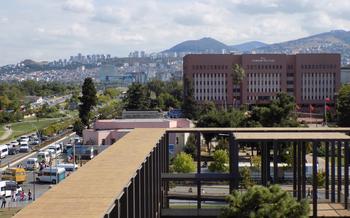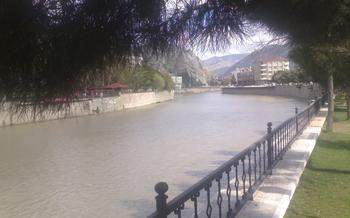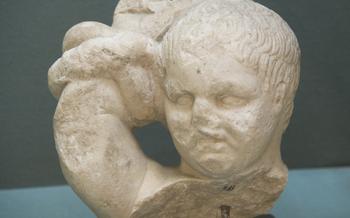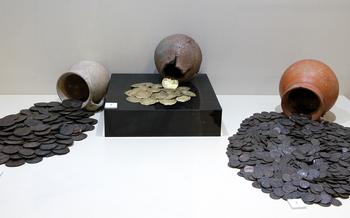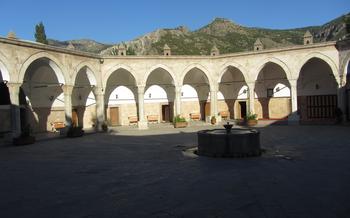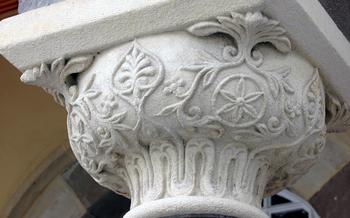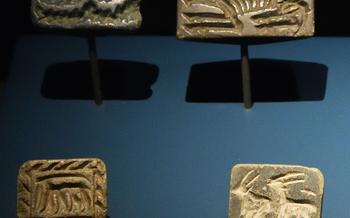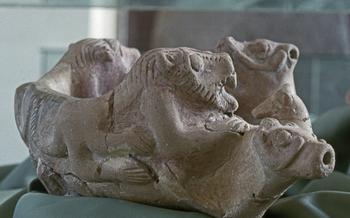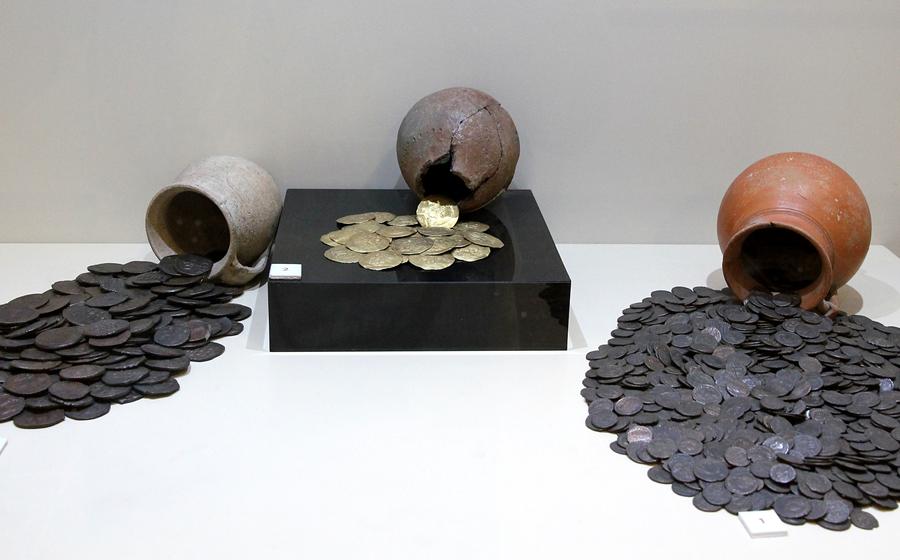
Amasya Archaeology Museum
- Amasya Archaeology Museum: A Journey Through Civilizations
- Treasures of the Hittites: Unveiling Ancient Civilizations
- Phrygian Legacy: Exploring the Kingdom of Midas
- Byzantine Elegance: Mosaics and Frescoes
- Islamic Heritage: Seljuk and Ottoman Artifacts
- Numismatic Delights: Coins Through the Ages
- Ethnographic Treasures: A Glimpse into Local Life
- Interactive Exhibits: Engaging with the Past
- Temporary Exhibitions: A Dynamic Showcase
- Guided Tours: Unveiling Hidden Stories
- Educational Programs: Learning Beyond the Walls
- Hours of Operation and Admission Fees: Plan Your Visit
- Insider Tip: Hidden Gems and Photography
Amasya Archaeology Museum: A Journey Through Civilizations
The Amasya Archaeology Museum stands as a testament to the rich cultural heritage of Turkey, housing a remarkable collection of artifacts that narrate the captivating story of civilizations that once thrived in this region. Located in the heart of the picturesque city of Amasya, the museum invites visitors to embark on a journey through time, tracing the footsteps of ancient civilizations that shaped the cultural tapestry of Anatolia.
Established in 1968, the museum occupies a beautifully restored 19th-century Ottoman building, harmoniously blending traditional architecture with modern museology. Its strategic location, overlooking the mesmerizing Yeşilırmak River, adds to the charm and allure of the museum, making it an inviting destination for history enthusiasts and culture seekers alike.
Treasures of the Hittites: Unveiling Ancient Civilizations
The Amasya Archaeology Museum proudly houses an exceptional collection of Hittite artifacts, offering a captivating glimpse into the mysteries of this ancient civilization. Among the highlights are rare inscriptions and tablets adorned with intricate hieroglyphs, providing valuable insights into Hittite history, mythology, and religious practices. These artifacts stand as testaments to the Hittites' remarkable achievements in writing and record-keeping.
The museum's Hittite collection is particularly significant as it originates from excavations conducted at various Hittite sites in the Amasya region. These excavations, meticulously carried out by teams of archaeologists, have unearthed a treasure trove of artifacts that shed light on the daily lives, artistic expressions, and technological advancements of the Hittites. From intricately carved stone reliefs to elegant pottery and bronze tools, each artifact tells a story of this once-powerful empire.
The Hittite civilization, which flourished in Anatolia from around 1600 to 1200 BCE, left an indelible mark on the region's history and culture. Their legacy extends beyond the artifacts displayed in the museum; it's woven into the fabric of Amasya itself, where Hittite ruins and remnants can still be found scattered throughout the landscape.
Exploring the Hittite collection at the Amasya Archaeology Museum is a journey back in time, an opportunity to uncover the secrets of a civilization that played a pivotal role in shaping the ancient world. It's a chance to marvel at their ingenuity, artistry, and the enduring impact they've had on the history of Anatolia.
Phrygian Legacy: Exploring the Kingdom of Midas
The Amasya Archaeology Museum houses a rich collection of artifacts that shed light on the Phrygian civilization, a powerful kingdom that ruled parts of Anatolia during the 8th to 7th centuries BC. Among the notable Phrygian treasures are intricately carved stone reliefs, bronze sculptures, and exquisite jewelry. One of the highlights is the famous "Golden Pectoral," a stunning piece of jewelry that showcases the exceptional craftsmanship of Phrygian artisans.
The Phrygian kingdom, ruled by the legendary King Midas, is renowned for its wealth and cultural achievements. The collection at the Amasya Archaeology Museum offers a glimpse into the life and times of this ancient civilization. Visitors can admire the intricate designs and symbolism depicted in the artifacts, gaining insights into Phrygian religious beliefs, mythology, and artistic traditions.
The connection to King Midas and the Golden Touch legend adds a touch of intrigue and fascination to the Phrygian legacy. According to Greek mythology, Midas was granted the ability to turn everything he touched into gold, a gift that eventually became a curse. While the Golden Touch story is a myth, it highlights the enduring legacy of the Phrygian kingdom and its association with wealth and prosperity.
Byzantine Elegance: Mosaics and Frescoes
The Amasya Archaeology Museum proudly showcases an array of exquisite Byzantine mosaics and frescoes, transporting visitors back to a time of religious devotion and artistic splendor. These intricate artworks, adorned with gold leaf and vibrant hues, depict biblical scenes, saints, and emperors with remarkable precision and detail. The mosaics and frescoes offer a glimpse into the rich symbolism and religious themes that permeated Byzantine society.
Thanks to meticulous preservation and restoration efforts, these precious artifacts have been meticulously restored to their former glory, allowing visitors to appreciate their beauty and craftsmanship. The museum's collection provides a valuable resource for understanding Byzantine art and iconography, shedding light on the cultural and religious significance of these enduring masterpieces.
Islamic Heritage: Seljuk and Ottoman Artifacts
The Amasya Archaeology Museum proudly showcases an array of Seljuk and Ottoman artifacts, offering a glimpse into the rich Islamic heritage of the region. Among the captivating exhibits are exquisite ceramics adorned with intricate patterns and vibrant colors, reflecting the mastery of Islamic potters. Metalwork pieces, such as finely engraved trays and intricately designed lamps, exemplify the exceptional craftsmanship of the era. Visitors can also marvel at a collection of textiles, including beautifully woven carpets and embroidered fabrics, each narrating a unique story of Islamic artistry.
Furthermore, the museum houses architectural elements salvaged from historic mosques and madrasas, providing insights into the architectural prowess of the Seljuk and Ottoman periods. These architectural fragments, including decorative tiles, carved lintels, and ornate mihrabs, showcase the fusion of Islamic aesthetics with local traditions.
Another highlight of the Islamic collection is the display of Islamic calligraphy, a revered art form in Islamic culture. Visitors can admire the graceful strokes and intricate compositions of Quranic verses and other religious texts, rendered in various calligraphic styles. These calligraphic masterpieces exemplify the profound reverence for the written word in Islamic tradition and showcase the exceptional skills of calligraphers throughout history.
The Islamic artifacts at the Amasya Archaeology Museum collectively illuminate the profound impact of Islamic rule on the region, highlighting the cultural contributions and artistic achievements of the Seljuk and Ottoman dynasties. These artifacts serve as tangible reminders of the rich tapestry of Islamic heritage that continues to shape the cultural identity of Amasya.
Numismatic Delights: Coins Through the Ages
The Amasya Archaeology Museum boasts an impressive collection of ancient coins that span various periods, offering a glimpse into the economic systems and trade routes of the region. These numismatic treasures, often overlooked by visitors, hold valuable insights into the monetary history of Anatolia.
The museum's coin collection includes a diverse range of specimens, from the archaic period to the Byzantine era. Each coin bears unique iconography and inscriptions, providing clues about the issuing authority, the value of the coin, and the prevailing artistic styles of the time.
Visitors can admire the intricate designs and motifs featured on these ancient coins, which often depict rulers, deities, or symbols of power. The collection includes rare and valuable coins, such as gold staters from the Hellenistic period and silver denarii from the Roman Empire.
By examining these coins, visitors can gain a deeper understanding of the economic and political dynamics that shaped the history of Amasya and the surrounding region. The collection serves as a valuable resource for researchers and enthusiasts interested in numismatics and ancient trade.
Ethnographic Treasures: A Glimpse into Local Life
The Amasya Archaeology Museum also houses a rich collection of ethnographic artifacts that offer a glimpse into the local life and cultural heritage of the region. Traditional costumes, ornate jewelry, and intricately crafted household items showcase the diverse ethnicities and customs that have shaped Amasya's unique identity.
Visitors can admire the vibrant colors and intricate embroidery of traditional garments, each stitch telling a story of craftsmanship and cultural significance. The museum's collection includes both everyday clothing and elaborate ceremonial attire, providing insights into the social hierarchy and special occasions celebrated in the region.
Moreover, the display of household items, such as hand-woven rugs, intricately carved wooden furniture, and traditional pottery, offers a glimpse into the domestic life of the local people. These artifacts showcase the ingenuity and resourcefulness of the craftsmen who created them, using locally sourced materials and traditional techniques passed down through generations.
By exploring the ethnographic collection, visitors can gain a deeper understanding of the rich cultural heritage of Amasya and the diverse communities that have called this region home throughout history. It's a testament to the enduring spirit and traditions of the local people, preserved within the walls of the Amasya Archaeology Museum.
Interactive Exhibits: Engaging with the Past
The Amasya Archaeology Museum offers a range of interactive exhibits that bring the past to life and make learning fun and engaging for visitors of all ages. These interactive displays allow visitors to explore artifacts, cultures, and historical events in a hands-on and immersive way. Multimedia presentations, touchscreens, and interactive games provide a deeper understanding of the museum's collection and the stories behind the artifacts.
One popular interactive exhibit is a virtual reality experience that transports visitors back in time to ancient Amasya. Visitors can explore the city's streets, markets, and historic landmarks as they would have appeared centuries ago. Another interactive exhibit allows visitors to try their hand at deciphering ancient inscriptions using replicas of Hittite tablets. This hands-on experience provides a glimpse into the challenges faced by archaeologists and the methods they use to unlock the secrets of the past.
The museum also offers workshops and educational programs that allow visitors to engage with the collection in a more active way. These programs cover a wide range of topics, from ancient pottery making to Islamic calligraphy. Visitors can learn new skills, create their own artwork, and gain a deeper appreciation for the cultural heritage of Amasya.
Temporary Exhibitions: A Dynamic Showcase
The Amasya Archaeology Museum is not just limited to its permanent collection; it also hosts captivating temporary exhibitions that showcase special collections and delve into specific themes related to the region's history and culture. These exhibitions are a testament to the museum's commitment to dynamic and engaging displays.
Collaborations with other museums and institutions bring diverse perspectives and expertise to these temporary exhibitions. Visitors can expect to encounter unique artifacts, thought-provoking installations, and immersive experiences that shed light on various aspects of Amasya's rich past.
Temporary exhibitions offer an opportunity to explore lesser-known facets of history, showcase recent archaeological discoveries, and present innovative interpretations of the region's cultural heritage. They add a layer of freshness to the museum experience, ensuring that visitors have something new to discover with each visit.
Whether you're an avid history buff or simply looking for a stimulating cultural experience, the temporary exhibitions at the Amasya Archaeology Museum are not to be missed. Check the museum's website or social media pages for upcoming exhibitions and special events to plan your visit accordingly.
Guided Tours: Unveiling Hidden Stories
Enhance your visit to the Amasya Archaeology Museum by joining a guided tour and delving deeper into the fascinating stories behind the artifacts. Knowledgeable guides will lead you through the museum's galleries, providing expert insights and anecdotes that bring the past to life. Learn about the significance of the Hittite inscriptions, the grandeur of the Phrygian kingdom, and the artistic achievements of the Hellenistic and Roman periods. Discover the symbolism and rituals associated with Byzantine mosaics and frescoes, and explore the legacy of Islamic rule through Seljuk and Ottoman artifacts.
Guided tours can be customized to suit your interests and time constraints. Whether you're a history buff, an art enthusiast, or simply curious to learn more about Turkey's rich cultural heritage, a guided tour will provide an unforgettable and enriching experience. Advance booking is recommended to secure your spot, especially during peak tourist season.
Educational Programs: Learning Beyond the Walls
The Amasya Archaeology Museum extends its educational mission beyond its physical walls through a range of engaging programs and initiatives. Workshops, lectures, and seminars delve deeper into various aspects of history, archaeology, and cultural heritage. These programs are designed for audiences of all ages, from school children to adults, fostering a love of learning and promoting historical awareness. Outreach programs reach out to schools and communities, bringing the museum's resources and expertise to a wider audience. Educational materials and resources are developed for teachers and students, supporting their exploration of history and culture in the classroom. Through these initiatives, the museum becomes a dynamic center for lifelong learning, encouraging visitors to continue their journey of discovery long after they leave its doors.
Hours of Operation and Admission Fees: Plan Your Visit
Hours of Operation: - The Amasya Archaeology Museum is open to the public from Tuesday to Sunday. - It observes the following hours of operation: - Summer season (April 15 - October 15): 8:00 AM - 7:00 PM - Winter season (October 16 - April 14): 8:00 AM - 5:00 PM
Admission Fees: - Regular admission fee: 30 Turkish Lira - Discounted admission fee (for students, seniors, and groups): 15 Turkish Lira - Free admission for children under 12 years of age, disabled individuals, and holders of the Museum Pass
Advance Ticket Purchase: - To avoid queues and ensure a hassle-free visit, you can purchase your tickets online through the museum's website or authorized ticketing platforms. - Online booking allows you to choose a specific date and time for your visit, guaranteeing your entry.
Insider Tip: - Consider visiting the museum during the shoulder seasons (spring and autumn) to avoid the summer crowds and enjoy a more relaxed experience.
Insider Tip: Hidden Gems and Photography
As you explore the Amasya Archaeology Museum, keep an eye out for hidden gems that often go unnoticed. In the Hittite section, don't miss the intricate rock reliefs depicting scenes of daily life and religious rituals. In the Phrygian collection, look for the exquisitely carved stone heads that exude a sense of mystery and grandeur. Among the Hellenistic and Roman artifacts, pay attention to the delicate pottery with its intricate designs and vibrant colors.
When it comes to photography, the Amasya Archaeology Museum offers ample opportunities to capture stunning images. However, flash photography is not permitted, so be sure to adjust your camera settings accordingly. Take advantage of the natural light filtering through the museum's windows to illuminate the artifacts beautifully. Experiment with different angles and perspectives to create unique and captivating shots.
Before your visit, check the museum's website or inquire at the information desk about any special events or programs that might be taking place. These events often offer unique insights into the museum's collection and provide opportunities to engage with curators and experts.
Remember, the Amasya Archaeology Museum is a treasure trove of history and culture, waiting to be discovered. With a keen eye for detail, a dash of curiosity, and a touch of photographic skill, you'll leave with a collection of memories and images that will last a lifetime.

